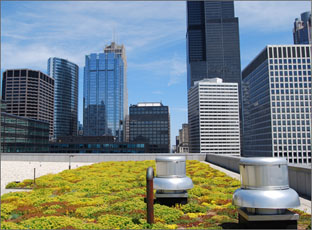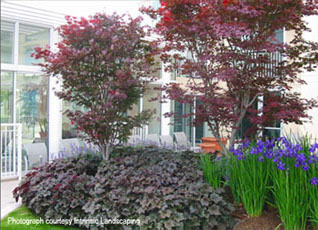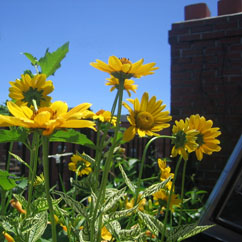ABOUT GREEN ROOFS - SYSTEMS & COMPONENTS
Systems
Vegetated green roofs are not container gardens but an engineered, built-up system of drainage, engineered media (soil) and plants that protect the structural integrity of the building. Upfront critical design goals, such as stormwater management, creating a “healing garden” for building occupants, creation of habitat for a specific insect, 100% protection of roofing membrane, or initial appearance, etc must be defined upfront to ensure the system is designed appropriately and meets customer expectations. All green roofs are not created equal!
In addition to the major design criteria noted above, the green roof system must also be designed for the specific roof waterproofing membrane, roof drains and other features and support vegetation chosen for the individual conditions (i.e. sun/shade) and climate (i.e. zone, rainfall).
If the structure can withstand the additional deadload, any design is possible just as for a landscaped area on the ground; however, plant selection also includes consideration for extreme conditions on rooftops such as wind and heat and the “soil” media is specially engineered to be lightweight and to hold water with minimal compaction over time. We do not recommend tray systems to our customers as they are much more expensive, less healthy for the plant communities and there is no data showing their durability and protection of the roof membrane over time.
-
Thin or “extensive” systems (3-6” of media) are functional and will require minimal maintenance and little or no irrigation. A 3” system weighs 21 lb/sf saturated and supports a wide variety of drought resistant, interesting plants.
-
Thicker or “intensive” system (>6” of media) can support a much broader plant variety and are more appropriate for areas where aesthetics are important such as hospital healing gardens or entertainment areas. They will also require more maintenance and are heavier requiring the building withstand at least an additional 42 lb/sf load.
Extensive system

Intensive system

![]()
Components
-
Root barrier (not shown) goes directly on the roofing membrane; however, it is not necessary if the membrane itself has root barrier protection.
-
Protection mat is often also a moisture retention mat designed to maximize water retention for plant health.
-
Drainage layer moves and stores water. The type varies greatly depending on the climate, water retention criteria, and thickness of the media which could crush some drainage types. Drainage may be a layer of special drainage media or made of synthetic material.
-
Separation fabric allows water to penetrate but stops the media from entering the drainage system.
-
Growth Media is engineered to be lightweight, to not compact over time and to have the right amount of organic matter to support the plants. All media should follow standards for green roofs.
-
Plants should be chosen for the specific roof conditions, media thickness and local climate. They can be planted as cuttings, plugs or installed as a vegetated mat which increases the cost. It is important that the customer understands that if cuttings or plugs are used, the roof will take two years to fully mature with 80% coverage.
-
Wind protection can be temporary or permanent depending on the conditions of the site and will not be visible once plants reach maturity.

